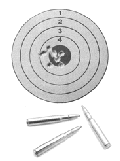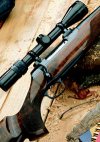Cyma Advanced L96 Bolt Action High Power Airsoft Sniper Rifle (Color: Black - Package a)
Cyma Advanced L96 Bolt Action High Power Airsoft Sniper Rifle (Color: Black - Package a)

The main purpose of the Sniper Rifle is to destroy valuable targets at extended ranges with aimed fire, and with as fiddling ammunition expended as possible. In almost cases, "the target" means a man (enemy soldier, armed criminal, terrorist etc). "As little armament as possible" often ways "ane shot". The range for sniper fire may vary from a few hundred meters or even less in police/counter-terror scenarios, to up to ane kilometer or more – in military or special operations scenarios.
Some sniper rifles, (generally large caliber ones) can also be used as anti-fabric weapons, to destroy (or more ofttimes, render unusable or inoperable), targets such as radar cabins, jeeps, parked shipping etc.
The history of sharp-shooting traces its ancestry well back into the 19th or fifty-fifty previously into the 18th century. An often noted instance of early on war machine sniping is the utilise of aimed fire during the American War of Independence (1775–1783), that came about because of the development of rifled muskets such every bit the Kentucky Rifle / Longrifle / Pennsylvania rile. In the history of mod warfare, sniper rifles have often been standard issue army rifles individually selected for accuracy, or privately purchased commercial target or hunting rifles. During WW1 and WW2 both sides used various full general consequence commodities action rifles (such as the Russian/Soviet Mosin M1991/30, United states of america Springfield M1903A4, British SMLE No.4(t), German G98k etc.) fitted with some kind of telescopic sight. Some general effect semi-automated rifles were also used in a sniper role, such as the Soviet SVT-twoscore and US M1 Garand. The origin of the term 'Sniper' refers to a custom during the British Raj period in India – the hunting of very modest, fast moving birds called 'Snipe'. It took a great shot to hit the wily creatures.. who would then exist referred to as a 'Sniper'.

The exercise of developing military sniper rifles from standard result firearms is still electric current in many countries. Usually, the manufacturer or special military unit of measurement will select some rifles for their ameliorate-than-average accuracy, then prefer these rifles for the sniper function (i.east. convert them from select-fire into semi-autos, add together ajustable stocks, bipods, scope mounts etc). Many military machine sniper rifles, discontinued in service or currently in employ, such as the US M21, German G3-ZF and G3-SG/i, were adult in that way.
Some sniper weapons were designed from scratch for marksmen to use, because the clients wanted some special characteristics that were unavailable in whatever service or commercial weapons. I such example is the Soviet SVD Dragunov rifle. It was designed at the request of the Soviet Army to extend the accomplish and effectiveness of infantry units; a lightweight, powerful and reliable semi-motorcar rifle, which has remained in service for nearly forty years.
Even so, the vast majority of sniper rifles have been based on existing commercially available hunting or sporting burglarize designs. Some of the best examples of this are the U.s. military sniper rifles: M24 and M40, forth with various custom rifles for law enforcement, based on Remington 700 actions. These are as well available for the general public in many hunting and target rifles. The famous SIG-Sauer range of sniper rifles (for example: the SSG 2000)are likewise based on their hunting rifles. Here are some other examples of sniper rifles, mostly police ones, based on the design of civilian target and/or sporting rifles: Blaser R93 Tactical (Deutschland), Sv-98 and MC-116 (Russia).
Generally, sniper rifles can be separated into three major categories: Miltary sniper rifles, Police/Law Enforcement sniper rifles, and Special Purpose sniper rifles.

Armed services sniper rifles. Along with the obvious needs of accurateness and sufficient constructive range, military use demands some other requirements. Military sniper rifles must non be besides heavy, because a sniper often has to conduct information technology for long hours, forth with ammunition and other equipment. War machine sniper rifles must be extremely reliable in any weather condition and climatic conditions and must withstand hundreds of rounds fired without proper cleaning and maintenance or whatever meaning loss of accuracy. Sniper rifles for military use must also be like shooting fish in a barrel to fieldstrip and simple to repair in field atmospheric condition. They must besides have backup fe sights, in case of the damage or loss of installed scope sights.
Military sniper rifles are also required to use standardised military ammunition, conforming to international state of war treaties and generally available to the troops. In most cases, the ammunition used for sniping is a variant of the standard caliber army cartridges (such every bit vii.62mm NATO or vii.62x54mm R), that have been peculiarly developed for sniping. Average effective range for the standard-caliber sniper rifles confronting a single human-sized target may be estimated as 700-800 meters for outset-shot kills. To extend effective range across k meters, more than powerful ammunition, such as .300 Winchester magnum (7.62x67mm) or .338 Lapua magnum (8.6x70mm), and the advisable weapon to fire information technology, needs to be used.
Military machine sniper rifles may be further separated into 2 tactical categories: sniper rifles themselves, designed to achieve aimed hits at long distances, and Designated Marksman Rifles (DMR), designed to provide accurate fire back up for line troops. While all "true" sniper rifles are considered bolt activity ones in club to accomplish maximum accuracy, the DMRs are commonly semi-automatics, such as the Russian SVD, High german G3ZF or HK MSG-90, to gain a higher charge per unit of fire (and therefore fast target acquisition). Only the differences betwixt them lay more in the tactical application, than in the rifle blueprint itself.
Police / Law Enforcement (LE) sniper rifles.These are required to be a somewhat different set up of tools. It might be said that in most military/state of war scenarios a wounded enemy is equivalent to, or preferred to a killed enemy. In LE and counter-terror (CT) scenarios a wounded criminal or terrorist is not neutralised and may lead to the decease of many innocent victims. Sometimes, the LE or CT sniper must not simply kill the terrorist, just hit a detail part of the torso – head, or manus holding the gun, etc. And then in full general, LE and CT sniper rifles require greater accuracy, but are used at shorter distances. The bulk of LE or CT scenarios require precision shooting at distances less than 300, or even 100 meters. These scenarios as well require an absolute minimum of shots – sometimes only one. This besides places demands of extreme accurateness and consistency of results in whatsoever weather weather on the operator and their weapons. LE and CT snipers don't necessarily have any limitations on selection of ammunition caliber though, as long as they fit the budget.
LE/CT sniper rifles often sport completely ajustable stocks to suit snipers of different stature, or for convenience and mobility in urban scenarios, where there are many potential obstacles and tight spaces. Sometimes these stocks are adjustable with a half-dozen ajustable screws. This is unsuitable for armed services sniper rifles, merely acceptable for LE sniper rifles, which are usually carried to the point of action in special cases.
Many American made LE sniper rifles are based on the hunting "varmint" rifles. Varmint rifles are small or medium quotient hunting rifles, designed to kill modest pests, such as squirrels, rabbits etc. Some LE sniper rifles, such every bit Remington 700 Police, are just Remington 700VS varmint hunting burglarize barrelled actions, bedded into sniper-styled stocks.
In Europe, some rifles in use by police force enforcement are specifically designed sniper rifles (such equally the Mauser 66, SIG-Sauer SSG2000 and Blaser R93 Tactical), and some are based on hunting rifles (such as the Steyr Scout Tactical). LE/CT snipers may use many kinds of ammunition, from .22LR for training and short-range sniping, to .308 Win, 6.5x55mm, .300 Win magnum etc.
Special Purpose sniper rifles. These may in turn exist split into 2 sub-categories: Large-quotient rifles for ulra-long range sniping and ani-fabric use, and South ilenced rifles for covert operations.
Large quotient sniper rifles are designed to utilize heavy machinegun ammunition, such as US and NATO .50BMG (12.7x99mm) or Russian 12.7x108mm. The effective range of rifles such every bit these is up to 1500 meters and over, depending on the size of the target and the quality of the ammunition. At the electric current time (September 2018) the longest recorded confirmed sniper kill is 3,540 meters. General purpose machinegun ammo ofttimes produces less than ideal accuracy (especially a lack of consistency), but recently some specialised "sniper" rounds have been developed in .50BMG caliber.
Silenced sniper rifles must exist used with special sub-sonic armament and removable or integral silencers (suppressors) to produce a lower audio report. No sound suppressor will finish a round breaking the audio barrier and producing a loudly aural 'crack' once fired. Therefore sub-sonic armament fires a bullet with less energy, remaining beneath the speed of sound and also decreasing the effective range downwardly to 300-400 meters at well-nigh. With the correct armament and audio suppressor, the sound of the gunshot might exist missed completely at distances of 100-200 meters at dark, or even at thirty-50 meters – mixed in with daily urban noise.
Sniper rifle Accurateness
The most common manner of describing the accurateness of a sniper rifle is to measure the average diameter of the circle that may be drawn around the grouping of bullet holes in a target. Normally, the rifle is fired from a secured position with groups of v (or 3) rounds, and so every group is measured. Boilerplate grouping diameter is the most common criteria of rifle accurateness.
Today, the thin line between "good" and "poor" accurateness is usually laid in 1MOA groups. 1 MOA (Minute Of Bending) is a measure of the angle that is formed by a triangle with the muzzle of the rifle as the top of the triangle and the group of bullet holes as the base. 1 MOA is roughly equivalent to 1 inch group diameter at 100 yards (91 meters), or to 2 inches at 200 yards etc. Then, if y'all read that burglarize XXXX shoots 1MOA groups, it ways that at 300 yards this rifle could identify 5 or and so bullets in circumvolve of no more than iii inches in diameter. Many modern sniper rifles, when loaded with the right ammunition, could shoot 0.5MOA, or even 0.3MOA, which ways ane inch groups at 300 yards, or 2 inch (50 millimeters!) groups at 600 yards (550 meters).
With the further development of sniper rifle and ammunition design the future of sniping is always changing. Developments such equally the Railgun, using an electromagnetic propulsion system threaten to become game-changers in the field of accurate long distance fire.
(c) Max Popenker, 2001
Cyma Advanced L96 Bolt Action High Power Airsoft Sniper Rifle (Color: Black - Package a)
Posted by: craigbeceents.blogspot.com
0 Response to "Cyma Advanced L96 Bolt Action High Power Airsoft Sniper Rifle (Color: Black - Package a)"
Post a Comment